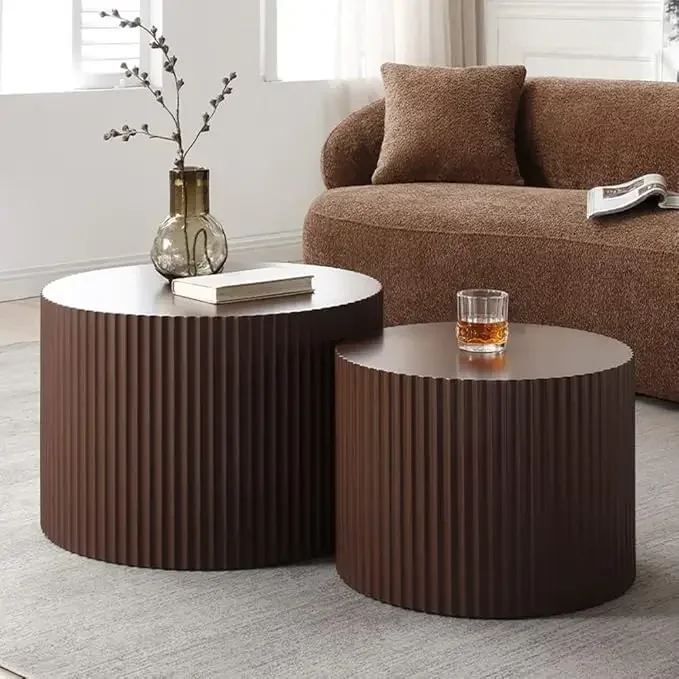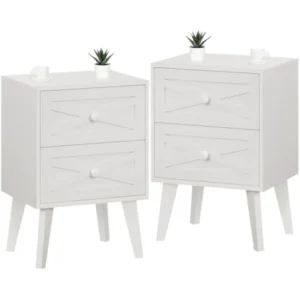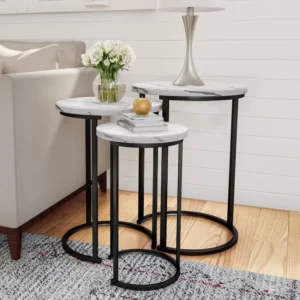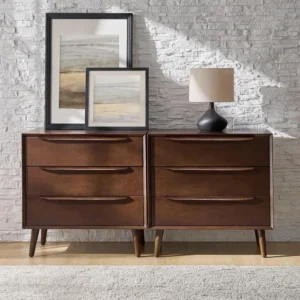The Magic of Round Coffee Tables in Creating Intimate Living Spaces
There’s something undeniably special about a well-designed living space that invites people to gather, connect, and relax. At the heart of these intimate settings often sits a round coffee table – a seemingly simple piece of furniture that plays an outsized role in creating truly cozy seating arrangements.
Round coffee tables naturally encourage connection in ways their angular counterparts cannot. Without corners to create barriers or establish hierarchy, circular tables foster a sense of equality and inclusion among everyone seated around them. The continuous curve creates a natural flow that guides conversation and brings people together.
The design advantages of round tables extend beyond just their conversational benefits. Their smooth edges eliminate sharp corners that can be hazardous in high-traffic areas, create better movement paths around furniture, and introduce a visual softness that balances the straight lines commonly found in sofas and chairs.
Design psychology has long recognized that circular shapes evoke feelings of safety, comfort, and protection. This isn’t just aesthetic theory – it’s rooted in how humans perceive and respond to their environments. The gentle curves of intelligent black mid-century coffee tables and other round designs tap into this fundamental response, creating spaces that feel instinctively welcoming.
As we explore the selection, arrangement, and styling of round coffee tables, you’ll discover how these versatile pieces can transform ordinary seating into extraordinary spaces for connection and comfort.
Why Round Coffee Tables Are Superior for Creating Cozy Atmospheres
The Social Circle Effect
Round coffee tables naturally encourage more equal participation in conversations. Unlike rectangular tables where people at the ends might feel disconnected, circular tables place everyone at the same distance, creating what designers call a “democratic space” where everyone feels equally involved and valued.
Flow and Safety Benefits
The absence of sharp corners creates smoother pathways around your seating area. This improved flow is not just a practical consideration but a psychological one – spaces that are easy to navigate feel more relaxing and comfortable. For homes with young children or elderly family members, eliminating potential hazards becomes an even more significant advantage.
Visual Softening
Most living rooms contain predominantly angular furniture – rectangular sofas, square armchairs, and straight bookshelves. A round coffee table introduces a pleasing visual contrast that softens the overall look of the space. The circular form creates a gentle counterpoint to these rigid lines, making the entire arrangement feel more balanced and inviting.
Psychological Comfort
Research in environmental psychology suggests that people generally perceive spaces with curved elements as more welcoming than those dominated by sharp angles. This perception isn’t just subjective – studies show curved furniture can actually reduce activity in brain regions associated with fear responses. The gentle forms of black mid-century modern coffee table styles create an atmosphere where people naturally feel more at ease.
Equitable Distribution
Round tables distribute people more evenly around a conversation area. This natural spacing creates what designers call the “sociable distance” – close enough for intimate conversation but with enough personal space to remain comfortable. Look at high-end hotel lobbies and exclusive lounges, and you’ll notice how often they incorporate round tables to create these perfectly balanced seating arrangements.
When choosing between different table shapes, many homeowners struggle with the decision. The question of whether to select a round or square coffee table for sectional seating arrangements depends on several factors, but the round option consistently creates a more fluid, conversation-friendly atmosphere.
Selecting the Perfect Round Coffee Table for Your Space
Finding the ideal round coffee table involves balancing practical considerations with aesthetic preferences. Here’s what to keep in mind as you make your selection:
Size Considerations
The diameter of your round coffee table should be proportional to your seating arrangement:
– For standard living rooms: 36-42 inches in diameter works well
– For smaller spaces: 30-36 inches prevents overcrowding
– For large, open layouts: 48 inches or larger may be appropriate
Aim for a table that leaves 16-18 inches of clearance between the table edge and surrounding furniture. This provides comfortable legroom while keeping the table within easy reach.
Height Proportions
The ideal coffee table height sits 1-2 inches lower than your sofa seat cushions. This relationship creates a comfortable reaching distance and maintains visual balance. Most coffee tables range between 16-18 inches tall, but always measure your specific seating to confirm the right proportion.
Material Selection for Coziness
Different materials create distinctly different atmospheres:
– Wood: Brings natural warmth and organic texture to your space
– Glass: Creates visual lightness and can make small spaces feel larger
– Metal: Adds industrial charm or glamorous shine depending on the finish
– Stone: Offers substantial presence and natural variation
– Upholstered options: Provide additional softness and can double as ottomans
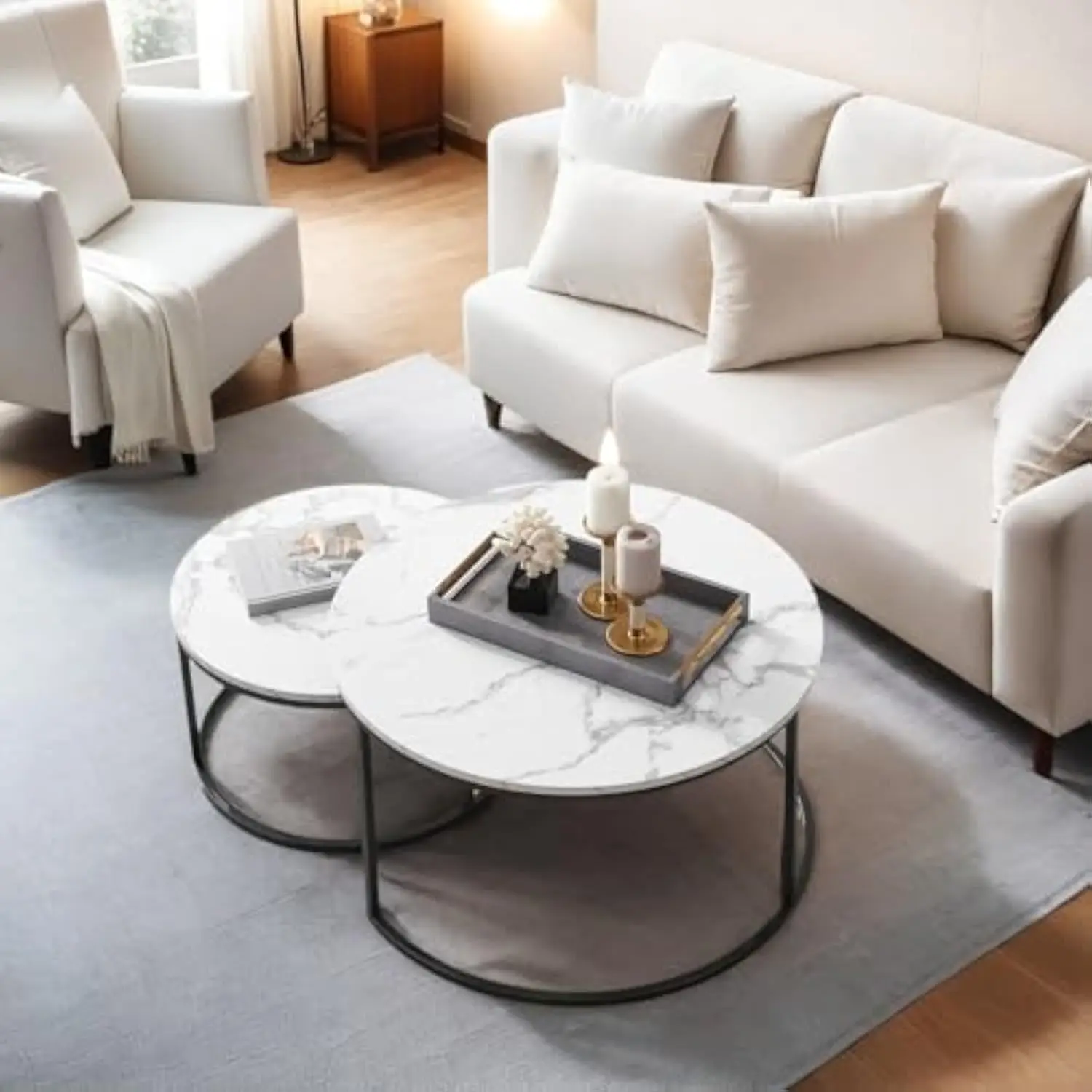
Design Elements That Enhance Comfort
Look for features that amplify coziness:
– Soft, rounded edges without sharp transitions
– Textural elements that invite touch
– Warm finishes like matte rather than high-gloss
– Stable construction that feels solid and secure
For particularly small spaces, considering appropriate coffee table sizes for small living rooms becomes even more important. The right proportions ensure your space feels cozy rather than cramped.
Optimal Placement: Arranging Round Coffee Tables for Maximum Comfort
The perfect coffee table needs perfect positioning to create a truly inviting seating arrangement. Follow these guidelines for optimal placement:
Distance Guidelines
Maintain 16-18 inches between your table edge and surrounding seating. This golden rule provides enough space for comfortable movement while keeping everything within easy reach. For main walkways around the arrangement, aim for at least 30 inches of clearance to ensure smooth traffic flow.
Seating Configuration Strategies
Different seating layouts require specific approaches:
Standard Sofa and Chairs
– Center the table in the conversation area, equidistant from all seating
– Position the table slightly closer to the sofa than to facing chairs
– Ensure sightlines remain open across the arrangement
Sectional Sofas
– For L-shaped sectionals: Position the table toward the corner while remaining accessible from both sides
– For U-shaped sectionals: Center the table in the open area, creating a balanced focal point
– When working with particularly large sectionals, coffee table strategies for large sectionals provide specialized approaches
Conversation Areas with Multiple Chairs
– Place the table at the center point of the chair arrangement
– Ensure each seat has equal access to the table surface
– Consider the natural pathways between chairs when determining exact placement
Small Space Solutions
– Choose a slightly smaller table diameter to maintain proper clearance
– Consider nesting tables that can be expanded when needed
– Position the table slightly off-center if it creates better flow through the room
Room Balance Considerations
Think of your table placement in terms of visual weight distribution. The table should anchor the seating arrangement without dominating it, creating a sense of stability and purpose within the space.
Design Harmony: Pairing Round Coffee Tables with the Right Seating
Creating a cohesive seating arrangement requires thoughtful pairing between your coffee table and surrounding furniture. These principles will help you achieve design harmony:
Balancing Different Sofa Shapes
Round tables complement virtually any sofa configuration:
– With rectangular sofas: The contrasting shapes create visual interest
– With curved sofas: The echoing curves create rhythmic harmony
– With sectionals: The round form softens the angular arrangement
Scale Considerations
Your coffee table should be proportional to your seating. A good rule of thumb is that the table diameter should be approximately two-thirds the length of your sofa. This creates visual balance while maintaining practical functionality.
Style Cohesion
While your coffee table doesn’t need to match your other furniture exactly, it should relate to the overall design language of your space. Consider these relationships:
- Material continuity: Echo materials from other furniture pieces
- Design era alignment: Pair styling black mid-century coffee table pieces with complementary mid-century seating
- Finish coordination: Match wood tones or metal finishes with accents throughout the room
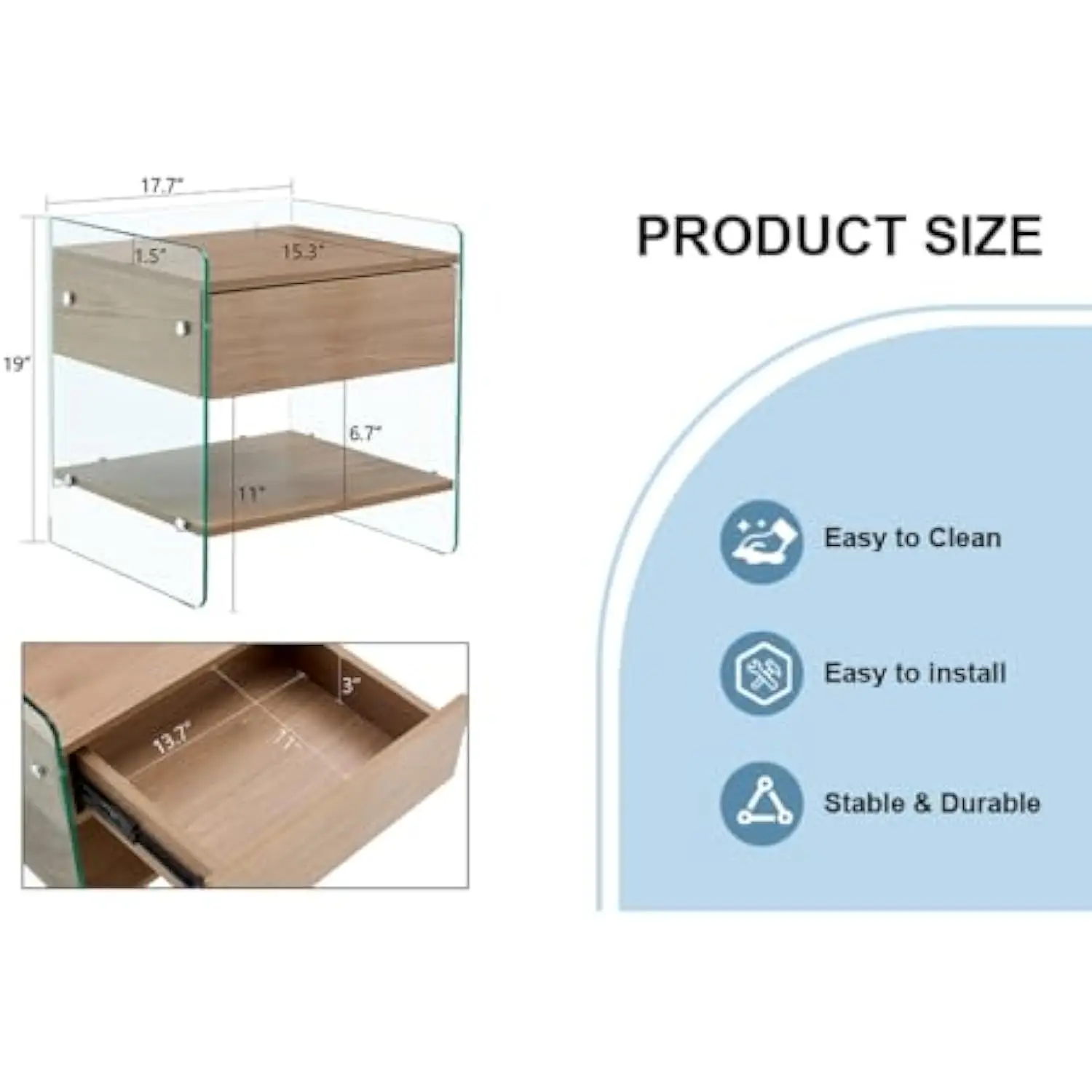
Creating Contrast or Harmony
Decide whether you want your coffee table to blend seamlessly with your existing furniture or serve as a contrasting focal point. Either approach can work beautifully:
- For harmony: Choose materials and colors that complement your seating
- For contrast: Select a table that introduces a new texture, color, or material while maintaining proportional balance
Layering Elements: Rugs, Lighting, and Textiles to Enhance Coziness
A truly inviting seating arrangement extends beyond the furniture itself to include the surrounding elements that enhance comfort and warmth.
Rug Selection
The right rug anchors your seating arrangement and adds literal and visual warmth:
– Choose a rug large enough to extend 18-24 inches beyond your coffee table edges
– Round or oval rugs can echo your table shape for cohesive design
– Textured rugs with higher pile create additional softness underfoot
– Consider patterns that complement (not compete with) your coffee table design
Lighting Strategies
Thoughtful lighting transforms the atmosphere around your coffee table:
– Table lamps on nearby surfaces create a warm glow at conversation level
– Floor lamps positioned behind seating provide comfortable reading light
– For maximum coziness, choose bulbs with warm color temperatures (2700-3000K)
– Consider dimmable options to adjust the mood throughout the day
Textile Additions
Soft textiles invite people to settle in and stay awhile:
– Layer throw pillows in varying sizes, textures, and complementary colors
– Add throw blankets draped over sofa arms or stored in nearby baskets
– Consider upholstered ottomans that can double as additional seating
– Introduce seasonal textiles to refresh the space throughout the year
Approaches for decorating black mid-century coffee tables and other styles can be adapted to any design aesthetic while maintaining these core principles of layering.
Coffee Table Styling: Creating a Cozy Focal Point
The surface of your round coffee table offers a canvas for expressing your personal style while enhancing the cozy atmosphere of your seating arrangement.
The Rule of Three
Professional designers often recommend grouping items in threes for visual interest. This might include:
– A stack of books, a small plant, and a decorative object
– A tray, a candle, and a small sculpture
– Three items of varying heights but related materials or colors
Height Variation
Create visual rhythm by including items of different heights:
– Something tall (like a slender vase or candlestick)
– Something medium (such as a small plant or sculpture)
– Something low (like a stack of books or a shallow bowl)
Styling Elements
The most inviting coffee table arrangements often include:
– Books: Choose titles with beautiful covers that reflect your interests
– Natural elements: Small plants, flowers, or interesting stones
– Ambient items: Candles, small lamps, or other soft light sources
– Personal touches: Small mementos or meaningful objects
– Functional pieces: Coasters, small boxes, or decorative trays
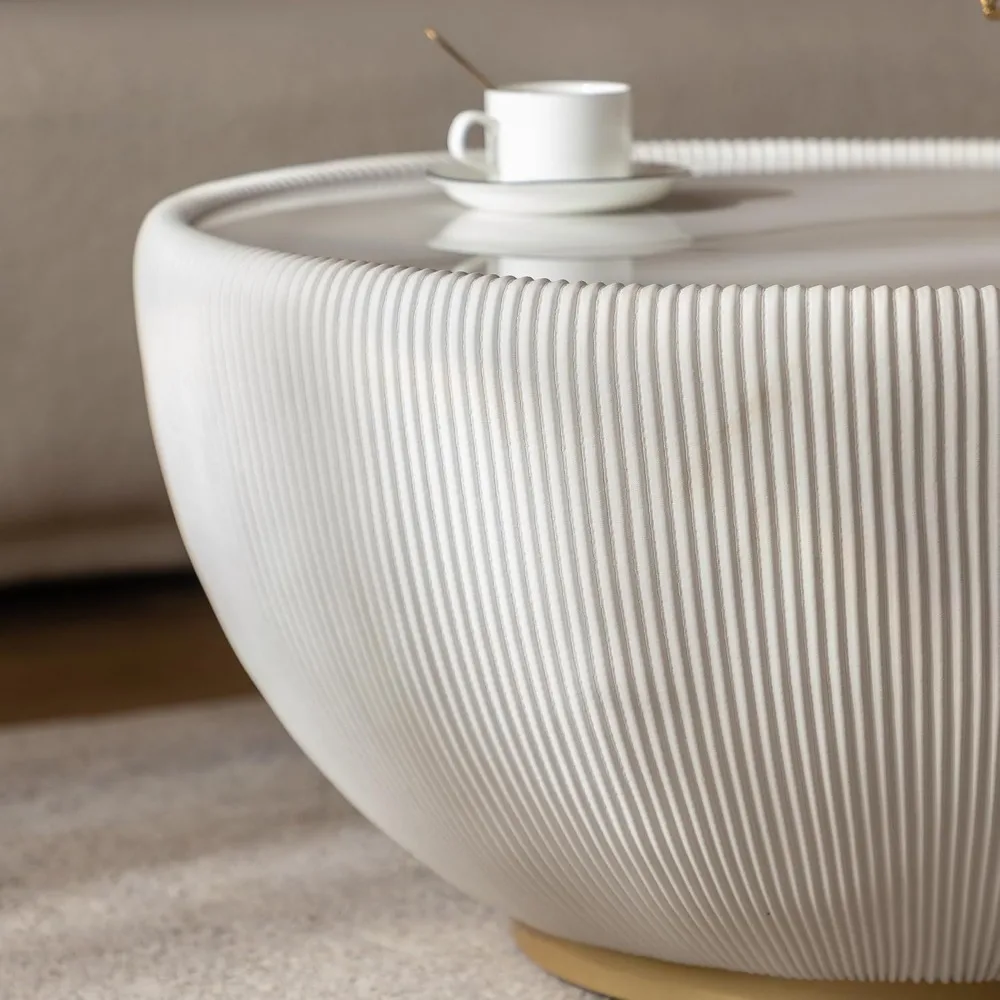
Organization Strategies
Maintain both style and function with these organizational approaches:
– Use decorative trays to corral smaller items
– Consider nesting tables as a space-saving solution that can be pulled out when needed
– Leave open space on the table surface for practical use
– Create seasonal variations that refresh your space throughout the year
Remember that the most successful coffee table styling balances aesthetic appeal with everyday functionality.
Special Considerations: Round Coffee Tables for Different Room Types
Different living spaces present unique challenges and opportunities for incorporating round coffee tables into cozy seating arrangements.
Small Living Rooms
In compact spaces, round coffee tables shine for several reasons:
– The absence of corners creates smoother traffic flow
– The circular shape visually takes up less space than square tables of similar size
– Transparent materials like glass can reduce visual weight
– Nesting tables offer flexibility for different needs
Open Concept Spaces
Round coffee tables help define and anchor conversation areas in open floor plans:
– Their distinct shape creates a visual boundary for the seating area
– Their central position establishes the purpose of the space
– Their form contrasts with the typically rectangular architecture
Family Rooms
High-use family spaces benefit from round tables’ practical advantages:
– No sharp corners for safety
– Sturdy materials that withstand daily use
– Storage options for games, remotes, and other items
– Durable surfaces that resist scratches and stains
Formal Living Areas
In more elegant settings, round coffee tables add sophistication:
– Fine materials like marble, brass, or polished wood elevate the design
– More ornate details can introduce character and visual interest
– Larger diameters can accommodate more decorative elements
– Glass tops can showcase beautiful rugs beneath
Explore our collection of mid-century modern round coffee tables to find options perfectly suited to your specific room type and needs.
Are Nesting Round Coffee Tables Better Than Single Tables for Flexible Spaces?
Nesting coffee tables offer a compelling alternative to single tables for many living arrangements, particularly those where flexibility is a priority.
The primary advantage of nesting tables is their adaptability. When fully nested, they occupy the footprint of a single table, making them ideal for smaller spaces. When entertaining guests, the smaller tables can be distributed throughout the seating area, ensuring everyone has a convenient surface within reach.
This versatility extends to styling options as well. Tables of different heights create natural visual layers, allowing for more dynamic arrangements of decorative objects. The varying levels also make it easier to create depth and interest in your table styling.
From a practical perspective, nesting tables can effectively double or triple your available surface area when needed, then return to a more compact formation when that space is required for other activities. This makes them particularly valuable in multifunctional rooms where the seating area might sometimes be used for exercises, children’s play, or other activities requiring floor space.
For truly flexible living environments, our mid-century modern nesting coffee tables provide elegant solutions that don’t sacrifice style for functionality.
How Can Round Ottoman Coffee Tables Enhance Seating Comfort?
Ottoman coffee tables represent the ultimate fusion of comfort and function in seating arrangements. These dual-purpose pieces serve as both footrests and surface areas, creating exceptionally cozy environments.
The upholstered surfaces of ottoman tables bring a tactile softness that hard-surface tables simply can’t match. This textural element adds immediate warmth to a room, both visually and literally. Fabric, leather, or velvet coverings invite touch and create a more relaxed atmosphere than wood or glass surfaces.
Many ottoman coffee tables also offer hidden storage – a practical benefit for maintaining a clutter-free environment. Blankets, magazines, remote controls, and other living room essentials can be tucked away yet remain easily accessible.
For styling, ottoman tables present unique opportunities and challenges. While they lack the hard surface for traditional displays, decorative trays can create stable platforms for lamps, books, or decorative objects while protecting the upholstery beneath.
Mid-Century Modern End Table Sets of 2, Mid-Century Modern Square Side & End Tables, Mid-Century Modern White Side & End Tables
$348.24 Select options This product has multiple variants. The options may be chosen on the product pageMid-Century Modern Solid Wood Coffee Tables, Mid-Century Modern Teak Coffee Tables
$879.95 Select options This product has multiple variants. The options may be chosen on the product pageMid-Century Modern Danish Coffee Tables, Mid-Century Modern Oval Coffee Tables, Mid-Century Modern Solid Wood Coffee Tables
$390.05 Select options This product has multiple variants. The options may be chosen on the product pageMid-Century Modern Nesting Side & End Tables, Mid-Century Modern Nesting Table Sets, Mid-Century Modern Round Side & End Tables
Price range: $239.35 through $273.06 Select options This product has multiple variants. The options may be chosen on the product pageMid-Century Modern End Table Sets of 2, Mid-Century Modern Walnut Side & End Tables
Price range: $978.89 through $1,957.38 Select options This product has multiple variants. The options may be chosen on the product pageMid-Century Modern Coffee & End Table Sets, Mid-Century Modern Coffee Table Sets, Mid-Century Modern Oval Coffee Tables
Price range: $257.48 through $331.04 Select options This product has multiple variants. The options may be chosen on the product page
For comprehensive seating solutions, Hearth Forms’ collection of mid-century modern table sets includes coordinated pieces that work together to create cohesive, comfortable arrangements.
What Coffee Table Shapes Work Best for Unconventional Seating Arrangements?
While round coffee tables offer exceptional versatility, certain unconventional seating arrangements might benefit from alternative shapes that address specific spatial challenges.
Oval coffee tables provide an excellent middle ground, combining the flow-enhancing benefits of rounded edges with the additional surface area of a rectangular form. This makes them particularly well-suited to longer, narrower seating arrangements where a purely round table might feel disproportionate.
For asymmetrical furniture groupings, free-form or organic-shaped tables can create a sense of intentionality in the arrangement. Their unique silhouettes add character while conforming to unusual spaces that might challenge more geometric options.
In particularly tight spaces with limited clearance, kidney or crescent-shaped tables can nestle closer to curved sofas while maintaining adequate pathways. This specialized form follows the contour of the seating, creating a harmonious relationship between the pieces.
For seating arrangements positioned in room corners or against walls, quarter-round or semi-circular tables make efficient use of space while maintaining the conversational benefits of curved edges. These shapes maximize available floor area while still providing functional surface space.
Explore our selection of mid-century modern oval coffee tables for alternatives that maintain many of the cozy benefits of round tables while addressing specific spatial needs.
For the broadest selection of options to suit any seating arrangement, browse our complete collection of mid-century modern coffee tables designed to create inviting, comfortable spaces that bring people together.

